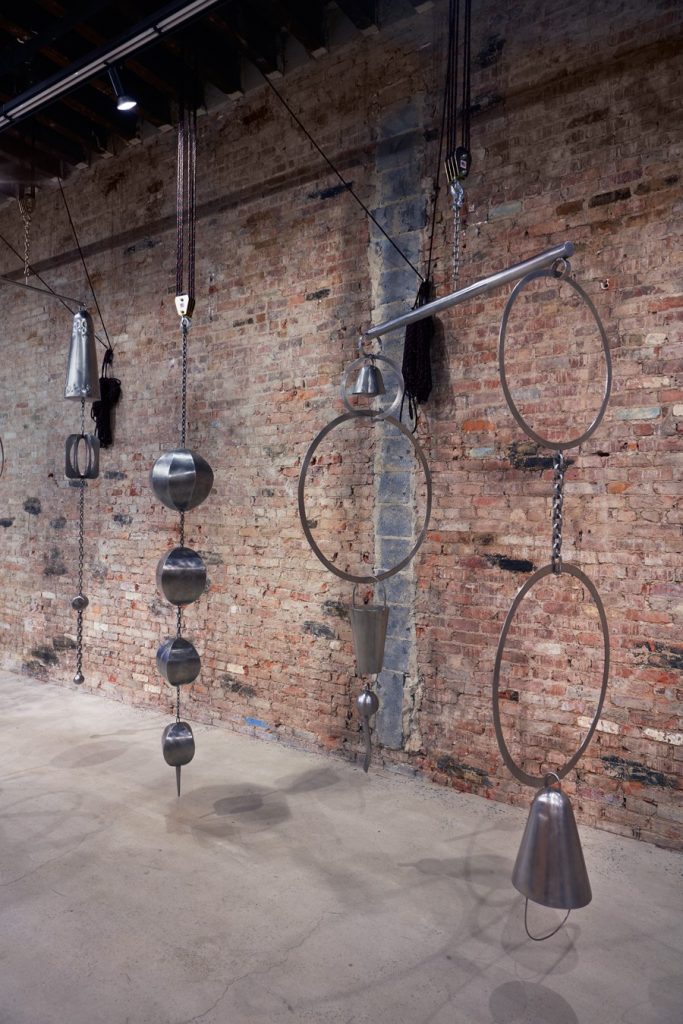CAA News Today
AC2024 Annual Artist Interviews Announced: Dawoud Bey and Anne Wilson
posted by CAA — Dec 11, 2023
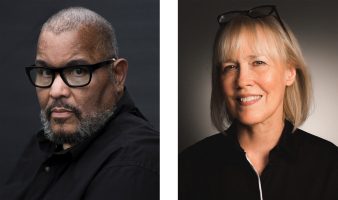
Dawoud Bey (photograph by Frank Ishman) and Anne Wilson (photograph by Joe Mazza)
CAA is thrilled to announce that Chicago-based artists Dawoud Bey and Anne Wilson will be the featured guests of the CAA 112th Annual Conference Annual Artist Interviews. Established in 1997, the Annual Artist Interviews, sponsored by the CAA Services to Artists Committee (SAC), remains the most highly anticipated event at the conference. This year, Bey will be interviewed by Elisabeth Sherman, Senior Curator and Director of Exhibitions and Collections, International Center of Photography, and Wilson will be interviewed by Elissa Auther, Deputy Director of Curatorial Affairs and the William and Mildred Lasdon Chief Curator, Museum of Arts and Design.
Dawoud Bey
Groundbreaking American artist and MacArthur Fellow, Dawoud Bey, is known for his evocative photographs and film works about communities that are often marginalized and for visualizing the oft disappeared histories of the Black presence in America. He began his career as a photographer in 1975 with a series of photographs, Harlem, USA, that was exhibited to critical acclaim in his first one-person exhibition at the Studio Museum in Harlem in 1979. His work has since been the subject of numerous exhibitions and retrospectives, including recently, Dawoud Bey: An American Project and Dawoud Bey and Carrie Mae Weems: In Dialogue, at museums and galleries worldwide, including the Art Institute of Chicago, the High Museum of Art, the National Gallery of Art, San Francisco Museum of Modern Art, the Getty Center, the Seattle Art Museum, the Museum of Fine Arts, Houston, the Walker Art Center, and the Whitney Museum of American Art.
His work has also been the subject of several monographs, including a forty-year retrospective monograph Seeing Deeply (University of Texas Press, 2017) and the recent Street Portraits (MACK Books, 2021). His critical writings on contemporary art and photography have appeared in a range of publications. Most recently, Elegy (Aperture, 2023) accompanies an exhibition at the Virginia Museum of Fine Arts and brings together the history projects and landscape-based work Bey has made since 2012.
Dawoud Bey received his MFA from Yale University School of Art and is currently Professor of Photography and a former Distinguished College Artist at Columbia College Chicago, where he has taught since 1998. He is represented by Sean Kelly Gallery, Stephen Daiter Gallery, and Rena Bransten Gallery.
Anne Wilson
Anne Wilson is a Chicago-based visual artist who creates sculpture, material drawings, and performances that explore themes of time, loss, and private and social rituals. Wilson’s artwork resides in permanent collections around the world, including the Metropolitan Museum of Art, Art Institute of Chicago, Museum of Contemporary Art, Chicago, Des Moines Art Center, Detroit Institute of Arts, Victoria & Albert Museum, London, Foundation Toms Pauli, Lausanne, Switzerland, and the 21st Century Museum of Contemporary Art, Kanazawa, Japan. Wilson was named a 2015 United States Artists Distinguished Fellow and is the recipient of awards from the Renwick Alliance, Textile Society of America, the Driehaus Foundation, Artadia, the Louis Comfort Tiffany Foundation, National Association of Schools of Art and Design, Cranbrook Academy of Art, the National Endowment for the Arts, and the Illinois Arts Council. She is represented by the Rhona Hoffman Gallery and Paul Kotula Projects. Wilson is a Professor Emeritus in the Department of Fiber and Material Studies at the School of the Art Institute of Chicago where she advises graduate students. Her upcoming project opens at the Museum of Arts and Design, NYC in 2024.
The AC2024 Annual Artist Interviews will be held on Friday, February 16, 4:30–7:00 p.m. CT at the Hilton Chicago. This event will also be livestreamed on YouTube.
Register now for the CAA 112th Annual Conference, February 14–17, 2024 in Chicago!
An Inaugural Evening with CAA Distinguished Awardees and Artists
posted by Allison Walters — Sep 13, 2021
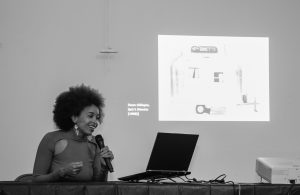
Nicole Fleetwood, recipient of CAA’s Frank Jewett Mather and Charles Rufus Morey book awards, discusses the inspiration behind her book, Marking Time: Art in the Age of Mass Incarceration.
Supporting excellence in the arts for over 100 years, CAA and its members are highly integrated into the fabric of art and its history, particularly in New York City. On September 1, 2021, CAA had the privilege to highlight its impact in an event featuring its distinguished awardees and partnerships. The event, an Inaugural Evening with CAA Distinguished Awardees and Artists, recognized the talent of CAA’s membership and reaffirmed CAA’s commitment and advocacy for scholars, artists, designers, teachers, young professionals, and many others.
Surrounded by recent artworks created by The League’s faculty members, CAA Executive Director and CEO Meme Omogbai introduced celebrated critic and curator Nicole R. Fleetwood. Fleetwood delivered a private presentation discussing her book and exhibition Marking Time: Art in the Age of Mass Incarceration, including detailed insights into the backstory and personal inspiration behind the important project. The book, published by Harvard University Press, unprecedently won both CAA’s Frank Jewett Mather and Charles Rufus Morey book awards in 2021. It was also reviewed across CAA’s publications, including The Art Bulletin, Art Journal, and caa.reviews. Fleetwood’s book accompanies a groundbreaking exhibition that began at MoMA PS1 in 2020 and continues to travel; it will open on September 17 at the Abroms-Engel Institute for the Visual Arts at the University of Alabama at Birmingham and be on view through December 11, 2021.
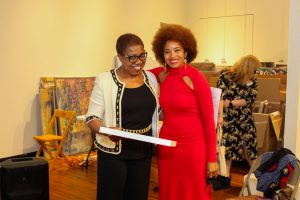
CAA Executive Director and CEO, Meme Omogbai, presents Nicole Fleetwood with the CAA Frank Jewett Mather and Charles Rufus Morey book awards.
The reception also commended CAA’s Outstanding Leadership in Philanthropy Award recipient, the Samuel H. Kress Foundation. The Samuel H. Kress Foundation has supported CAA in its mission for over 60 years, through programs in art history and, more recently, digital transformation. With support from the Samuel H. Kress Foundation, CAA’s new strategic focus on digital initiatives will bridge history, scholarship, and accessibility to better serve all segments of its constituency, especially underprivileged audiences.
The Art Students League of New York graciously hosted CAA for this event. Like CAA, The League is an organization with a long history of promoting the arts and education. Indeed, CAA and The League have been highly integrated into the fabric of art and its history in New York City and have been closely intertwined, collaborating on several events and initiatives dating back to at least the 1950s.
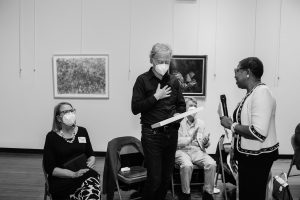
CAA Executive Director and CEO, Meme Omogbai, presents Max Marmor, President of the Kress Foundation, with the CAA Philanthropy Award.
Located west of The League, the site-specific exhibition Re:Growth, A Celebration of Art, Riverside Park, and the New York Spirit, curated by Karin Bravin, included several artists from the CAA community: current CAA Board Member Dahlia Elsayed, former Board President DeWitt Godfrey, and CAA member Jean Shin. While the weather prevented a group walk-through of the exhibition, Elsayed spoke to attendees about the unique exhibition, her sculpture in the show, and its significance.
Altogether, the evening underscored CAA’s wide reach and impact in the arts and the talent of its members. As the largest international organization of arts professionals, CAA has a vital mission to promote the visual arts and their understanding through intellectual engagement, commitment to diversity, and advocacy. This upcoming year will provide opportunities to celebrate several milestones in this mission. CAA’s next virtual event in November 2021, will celebrate the 10-year anniversary of the publication of CAA’s seminal history, The Eye, the Hand, the Mind: 100 Years of the College Art Association. In February 2022, CAA will host its first hybrid Annual Conference in Chicago and online; registration will open in October.
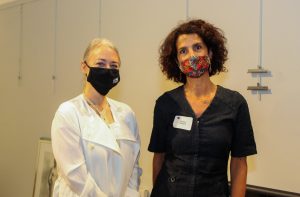
Jennifer Rissler, Vice President for External Relations and acting CAA Board President, and Dahlia Elsayed, current CAA Board Member and artist, both spoke at the event.
CWA Picks for December 2019
posted by CAA — Dec 03, 2019
CAA’s Committee on Women in the Arts selects the best in feminist art and scholarship to share with CAA members on a monthly basis. See the picks for December below.
…for Gloria Kisch
dieFirma, New York, New York
October 13, 2019 – January 5, 2020
The inaugural exhibition at dieFirma, a new gallery and arts space nestled in the bustling Bowery at 32A Cooper Square, New York, celebrates the life of multidisciplinary artist Gloria Kisch (1941-2014). An impressive presentation reveals the range and significance of Kisch’s abstract sculptures and highlights her late series of metalwork constructions called Bells (2000-2003) and Flowers (2007-13); functional furniture and objects (benches and chairs); and early hard-edge paintings from the 1960s. Also displayed are ephemera from the artist’s extensive personal archive. A large body of drawings by British artist Jane Gifford accompanies the installation. Gifford turned to Kisch’s sculptures for inspiration and produced a collection of smaller watercolors that offer a fascinating interplay and homage; the gentle conversion of three-dimensional volumetric space through line and gesture encourages a subdued reciprocity between the two artists. Kisch’s metalwork equally invites multiple readings and comparisons to likeminded artists who crossed media and arbitrarily ignored traditional fine art, craft and design hierarchies. Utilizing hand-forged stainless steel, Kisch’s statuesque Bells take on a corporeal presence—linked geometric elements vertically hang, some extenuated and stretched, others widely berthed. But it is through their mythic presence that the viewer makes connections to sculptors who gloriously filled and emptied space, recalling the mobiles of Alexander Calder and totems of David Smith, the quasi-furniture of Isamu Noguchi, the calibrated wire constructions of Ruth Asawa or the scaled modular systems of Gego. Kisch’s series of wall-mounted Flowers bring a playful pop of color with their reflective metal petals and flexible use of materials. Kisch’s own history is equally as colorful.
For Neither Love Nor Money: Women’s Invisible Labor
San Marco Gallery in Archbishop Alemany Library, Dominican University, San Rafael, California
November 12, 2019 – January 17, 2020
Using real-life work data and personal narratives, artist Sawyer Rose highlights the pervasive inequalities working women face via visualization sculpture. Rose collects data herself from female-identifying workers from across the US, and translates it into large-scale installations that visualize the number of hours women log at paid and unpaid jobs, demonstrating the physical, emotional, and practical effects of disproportionate labor loads. With the installation, she photographs the women lifting and carrying her sculpture, visually bearing the real and physical burdens. Dawline, a teaching artist, teaches elementary school and balances multiple volunteer art tutoring positions. Rose’s installation for Dawline is dozens of gold and silver leafed objects hanging from the ceiling, made of linen, cotton, rope, gold and silver leaf, metal clasps and rings, wood, stones, acrylic, and enamel. Dawline is depicted in a photo next to the installation with the stones on her lap, representing the weight of both her paid and unpaid jobs. The accompanying text includes statistics around volunteerism, disproportionately falling on women. The multi-layered, educational, and visually driven exhibit, says the artist, “may not represent your life or your particular situation, but…definitely depicts the lives of many women you know and love, women who work with you or for you…The good news, though, is that everyone can reap the benefits of a gender-equitable workforce: increased Gross Domestic Product (GDP), more profitable businesses, and healthier, happier partners and children.”
Natalia LL: I Record Common Events
lokal_30, Warsaw, Poland
November 29, 2019 – January 24, 2020
The widely recognized 1969 essay by Carol Hanisch, an American feminist activist, entitled “The Personal Is Political,” was not known in communist Poland in 1970s. And yet, many women artists, including Natalia Lach-Lachowicz, known as Natalia LL, were using their bodies and most intimate surroundings to explore what it meant to be and become a woman. In her 1972 manifesto “Transformative Attitude,” Natalia LL wrote that “Art is in the process of becoming in every instant of reality,” and that she “records common events.” Since her studies at the Academy of Fine Arts in Wrocław, Poland, and in her artistic career spanning almost 50 years, Natalia LL has been using photography and film to investigate everyday bodily activities such as sleeping, eating, or speaking. Her works engage with issues concerning the rise of consumer culture and the fetishization of objects and bodies. She is known as a pioneer of feminist avant-garde in Poland and has become one of the first Polish women artists to be influential in the international feminist art movement of 1970s. The exhibition in lokal_30 features some of the key works of the artist alongside photographs which Natalia LL sent for an exhibition in Paramedia gallery in Berlin in 1974 and which have never been displayed in Poland.
16th International Triennial of Tapestry: Breaching Borders
Central Museum of Textiles, Łódź, Poland
October 5, 2019 – March 15, 2020
Łódź, a city in central Poland, has been cultivating its textile industry traditions since the 19th century. The International Trennial of Tapestry is the oldest and most important presentation of phenomena connected to the medium of textiles. For the first time in its history, the formula of the Triennial has been opened and artists themselves could apply to participate. It has also been enriched by the introduction of the role of the curator, Marta Kowalewska, and focus on an overarching key theme, which for the 16th edition is “Breaching Borders.” The understanding of borders is multi-layered. Artists from 21 countries in 55 selected works explore the threats and fears marking our contemporary condition, historical references, and personal stories that question the concept of borders as sources of conflict and trauma. The theme also references textiles and their place as one of liberated arts on one hand, and their structure enabling interlacing and layering of meanings and perspectives. The exhibition includes works of many significant women artists, such as Dorte Jensen, Ola Kozioł, Lucy Brown, Lisa Palm, Caroline Achaintre, Agata Borowa, Dobrosława Kowalewska, Anne Wilson or Joanna Malinowska, among others. It also features the unique work titled Your Things, a 20-meter fabric created in the Center for Foreigners in Łuków, Poland by Chechen refugees Zaira Avtaeva, Zalina Tavgereeva, Liana Borczaszvilli, Makka Visengereeva, Khava Bashanova, and Alina Malcagova, who await international protection. The work was created as part of a mini-grant of the Feminist Fund implemented in cooperation with the For the Earth Association according to a concept developed by Pamela Bożek.
Margaret Jacobs: Steel Medicine
Boise Art Museum, Idaho
June 8, 2019 – April 26, 2020
Artist Margaret Jacobs couples her steel sculptures celebrating Indigenous culture with early twentieth century ironworking tools, exploring the tension and harmony between forces of nature and humans. Jacobs’ sculptures, such as Steel Medicine, depict medicinal plants with a strong aesthetic via the dark color and heavy materiality of the metal, complemented by the softness of the sinewy shadows of the sculpture on the wall, emphasizing too the resilience and fragility of nature. Jacobs, a member of the St. Regis Mohawk Tribe, created two new series, Steel Medicine and Survival Medicine, on view, especially for this exhibit. “My culture inspires me to create pieces charged with power, strength, and beauty,” writes the artist in her statement, and in turn, “I believe my work celebrates indigenous culture with a bold, powerful aesthetic.”
An Interview with Roberto Tejada, CAA’s New Vice President for Diversity and Inclusion
posted by CAA — Jun 05, 2018
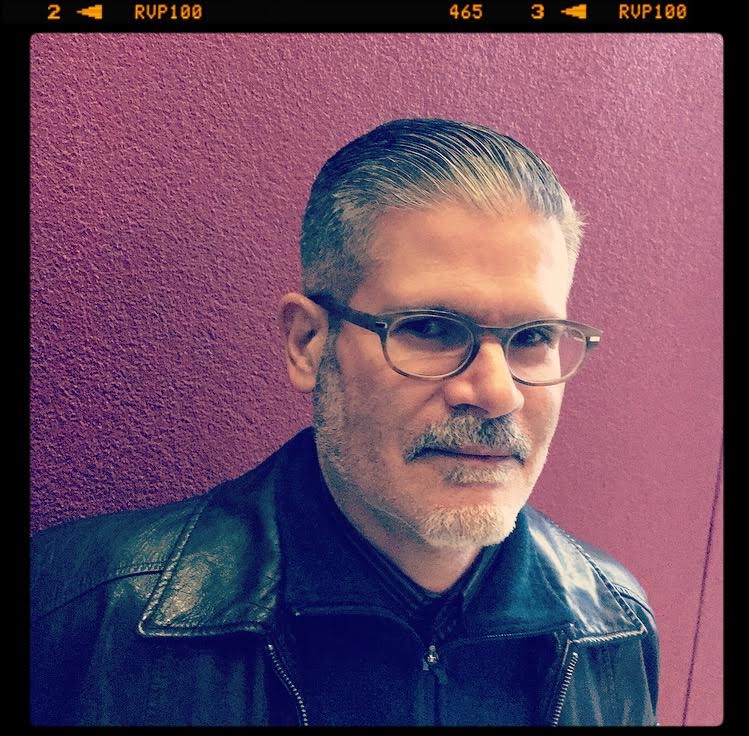
Roberto Tejada
Last week, Roberto Tejada, CAA’s newly elected vice president for diversity and inclusion, talked with Hunter O’Hanian, CAA’s executive director, about the state of the field and why achieving true diversity is so difficult in the arts field.
The interview accompanies CAA’s newly created Values Statement on Diversity and Inclusion, adopted by the CAA board of directors in May 2018.
Hunter O’Hanian: You were elected as CAA’s first vice president for diversity and inclusion last October. Can you tell me why that position was created and what you hope to accomplish?
Roberto Tejada: Let me answer that first with a confession. I joined CAA as an emerging professional many years ago, newly positioned in academia, but not altogether of academia. I’d spent a decade of my formal and informal working years in the art and literary worlds of 1990s Mexico City. When I returned to the US, there were few art history PhD programs with faculty specializing in Latin American and US Latinx art; the art-related disciplines were not especially open or inclusive, and the CAA and its conference consistently felt to me like alienating spaces. So I was never much engaged as a member.
A few years ago, in 2013-2014, I had the opportunity to be in attendance at a CAA retreat held at Clark Art Institute, where I was a fellow. I listened to CAA’s leadership in discussions that led to the drafting of its current strategic plan; and I was impressed with the various commitments among its stakeholders to issues of advocacy and questions of diversity and inclusion. Those conversations inspired me to consider it was possible to effect change from within, so I agreed to put myself forward and was elected by the board in 2016 to serve as Secretary.
My understanding was that CAA’s membership had long sought leadership, whether on the board or staff, to embody, energize, and encourage a commitment to diversity and inclusion at every level of the organization. Under review were resolutions that resulted from the perseverance of CAA’s Committee on Diversity Practices, other subcommittees, and the efforts of many individual members, including the “Resolution to Create a New Officer with the Title of Vice President for Diversity and Inclusion” and the “Resolution Adopting a Values Statement on Diversity and Inclusion.”
Why was the position was created? It’s no secret that the membership of scholarly associations is in decline and that cultural institutions more broadly jeopardize their relevance and sustainability when they fail to make diversity and inclusion central to an organization’s structuring values. For the last decades, cultural life and fields of study have been categorically redefined by the art and scholarship of underrepresented groups; by artists and intellectuals of color, LGBT scholars, and others who have faced the challenges of institutional spaces, often without networks of support.
Also, insofar as the language of diversity and inclusion readily serves the neoliberal agenda, it’s conveniently adopted and used by universities and other organizations as a cover for actual equity in terms of race, ethnicity, skin color, and other social markers of difference, visible and invisible. The promotion of diversity and inclusion involves redressing an entanglement of past narratives but with a steady eye on the present and future. One way to view it, appropriate to art and design, is as a work-in-progress. CAA has been watchful of currents in higher education and the arts and it has led advocacy efforts of great impact for diversity and inclusion. If equity and inclusion were to become the priority issue for CAA and its membership, the human and intellectual vibrancy of our respective institutions could begin to more accurately reflect the plural narratives that have led to the composition of contemporary society. I’m passionate about the role that the board and membership can play to empower others, and so change the faces of CAA.
But in the context of current political discourses in the government and media, the challenge of advancing equity in the arts and humanities is to move beyond the model of appealing to hearts and minds, and to encourage policy-change guidelines that are concrete channels to access.
HO: What particular issues do you see in the fields of art history and visual arts with regard to diversity, either in the academic world or museums? A high percentage of CAA’s members are white. Is there a reason for that?
RT: Despite the multicultural context of the so-called global turn, the fields of art history and the visual arts have not been particularly hospitable to persons deemed different. If you serve on enough admission and hiring committees at different kinds of institutions, you cannot ignore the implicit biases that continue to perpetuate a lack of equity. Although fields of research and curricula have adapted to account for plural histories, the bodies that make art and design, that care and write about practices, history, preservation, and display at universities and museums, are still overwhelmingly white. It’s challenging to recruit emerging professionals of color who feel underrepresented in CAA. Members within the organization, however, have effected change. For example, the US Latinx Art Forum (USLAF) is an affiliated society that was formed by CAA members, and it now includes around 300 artists, art historians, curators, and other art professionals. Its founders Adriana Zavala and Rose G. Salseda, responded to “ongoing marginalization of US Latinx art within the academy and specifically within both ‘American’ and ‘Latin American’ art history.” USLAF’s members advocate for scholarship at the intersections of Latinx, African-American, Asian-American and Indigenous art and art histories. Its efforts are positioned to inspire artists and scholars of color to join and participate in CAA.
HO: In May, the CAA board of directors passed its Values Statement on Diversity and Inclusion. Why this particular statement now?
RT: That statement was a collaborative effort that resulted from discussions first among members of the Committee for Diversity Practices; then among board members, who voted to pass the statement. The statement will strike many as belated. As a starting point, it has been retroactively amended to the Strategic Plan and will serve as a guiding frame of reference for all CAA initiatives and actions moving forward.
HO: What can practitioners/educators in the field do to help diversify their own departments or student cohorts?
RT: Flora Brooke Anthony, Chris Bennett, and Katherine Brion facilitated an excellent workshop at the last CAA Annual Conference in Los Angeles on the “disconnect between intention and practice” and on why faculty hiring guides and administrative initiatives have been unsuccessful at creating diverse departments. Some of the short answers have to do with the professional pipeline, implicit bias, the comfort zone idea of “best fit,” and the social factors to do with accumulation of advantage and disadvantage. The long view requires challenging our membership to lend efforts and energies in the service of inclusion that actually enhances one’s research imagination at the departmental level and in the classroom. There are resources on CAA’s website: standards and guidelines for diversity practices, links to a database on multicultural teaching, digital resources with classroom ideas, archives of digitized imagery, and bibliographies of global visual culture. There are ways that practitioners and educators in art and art history departments can partner with units and other departments on campus whose faculty and graduate student research addresses the scope of human diversity and the structures of exclusion or discrimination. Departments can explore the possibility of creating residency fellowship for recent MFAs or PhDs who bring different embodied experiences. There are CAA-sponsored web platforms to be explored that could serve to link emerging professionals and graduate student to create an open space for questions and concerns relevant to faculty of color in departments unfamiliar with diversity needs. Department can actively recruit from diverse universities and community colleges, with an openness to candidates with experiences and expertise not always associated with the arts.
It’s important to remember as well that students and professionals of color at different stages of a career path often complain that so-called target opportunities are experienced and perceived as marginalizing, empty appeals to special treatment that once again delegitimizes the actual merits and recognition of excellence among underrepresented future scholars, designers, artists, curators and other museum professionals.
HO: Do you see movements, changes and trends on the national level that is making diversity work easier or more difficult?
RT: I think there is enough evidence to discern that the rhetoric fueling racial fears and resentment against minorities, enabled nationally and internationally by those in power, is inclined to have ripple effects in academia and in the arts. It has entitled attitudes and actions that have made the need to advocate for diversity and inclusion all the more urgent.
For more on CAA’s advocacy efforts, click here.
Click here to access the CAA Arts and Humanities Advocacy Toolkit.
August 2017 Picks from CAA’s Committee on Women in the Arts
posted by CAA — Aug 01, 2017
Hương Ngô: To Name It is to See It
Firelei Báez: Vessels of Genealogies
DePaul Art Museum
935 W Fullerton, Chicago, IL
April 27–August 6, 2017
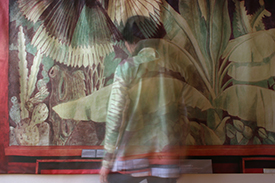
Hương Ngô, study for the video Hidden from Plain Sight, 2017 (artwork © Hương Ngô)
In concurrent exhibitions, the DePaul Art Museum presents Firelei Báez, Vessels of Genealogies, and Hương Ngô, To Name It is to See It. Báez, a Miami-based Dominican-American artist, is known for her use of textiles, patterns, and bright colors. She often depicts identity through the use of hairstyles and tattoos in her large-scale paintings, evoking both beauty and political implications “for those whose cultural identities have remained traditionally absent from dominant culture.” While Báez migrated to the United States, her work also addresses identity formation experienced by those who grew up in Latin, Caribbean, and African regions. She “challenges the basic idea of how race is experienced in the US—a condition defined as binary and black or white. In her work, one can appreciate that she is many cultures. She expresses the consciousness of a new generation eager to embrace their cultural prowess in terms of hybridity.”
In To Name It is to See It, Ngô, focuses on Vietnamese anticolonial organizer Nguyễn Thị Minh Khai. Ngô draws connections between language and seeing. The artist said, “‘To Name It Is To See It’ evokes the promise of a discursive practice, identifying an injustice by name is the first step to understanding it and working towards change. At the same time, there is deception to the title because identification was a preoccupation of the colonial authorities….” The exhibition by Ngô features more than twenty-five individual pieces of art ranging from photos to video and fabrics.
SaveArtSpace: The Future is Female
Through Summer 2017
Various locations throughout New York City
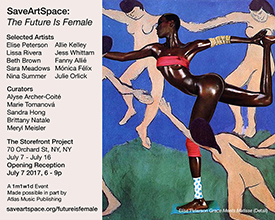 In this all-woman gallery and public art exhibition, The Future Is Female by SaveArtSpact features female artists on advertising spaces and billboards throughout the New York City area during summer 2017. The exhibit aims to expand upon the mainstream definition of “the female gaze” through works that reflect the multifaceted reality of womanhood in the twenty-first century and that expand upon society’s traditional ideals of femininity.
In this all-woman gallery and public art exhibition, The Future Is Female by SaveArtSpact features female artists on advertising spaces and billboards throughout the New York City area during summer 2017. The exhibit aims to expand upon the mainstream definition of “the female gaze” through works that reflect the multifaceted reality of womanhood in the twenty-first century and that expand upon society’s traditional ideals of femininity.
“One such woman is artist Elise Peterson,” writes Priscilla Frank in a HuffPost review, “whose piece Grace Meets Matisse injects a photographic image of Grace Jones into Henri Matisse’s 1910 Dance, placing her in the center of a ring of naked dancers. The image puts Jones’ black body into an image previously filled with white bodies, juxtaposing the flesh of the painted figures with the three-dimensional glow of Jones’ self-actualized body, mid-performance.” (http://www.huffingtonpost.com/entry/feminist-art-new-york-billboards_us_594abba7e4b0312cfb60fb92)
The work was curated by Meryl Meisler, Marie Tomanova, Alyse Archer-Coité, Sandra Hong, and Brittany Natale. In addition to Peterson, artists include Allie Kelley, Beth Brown, Fanny Allié, Jess Whittam, Julie Orlick, Lissa Rivera, Mónica Félix, Nina Summer, and Sara Meadows. Peterson’s work can be viewed in various locations throughout New York City, including Grand Street and Ludlow Street (343 Grand Street).
Jeanine Oleson
Commonwealth & Council
3006 W 7th St. Suite 220, Los Angeles, CA
July 8–August 19, 2017
The amplification of sound and image is at the center of Jeanine Oleson’s powerful exhibition at Commonwealth & Council. Using natural materials such as shell and glass within a performance-based lexicon, Oleson examines the effects of production under late capitalism, the meanings of community, and bodily experience. Three-dimensional imaging technology is employed to render visible what we already see but which we might not value; and elsewhere a transducer speaker made of shell expertly turns an object of childlike wonder into a proxy for political speech. Although not specifically positioned as a pendant to Oleson’s Hammer exhibition, concurrently on view, many of the interests in the two shows are similar, and benefit from a close read. At issue in both is how one might become a conductor—realizing the longing for a political elsewhere—using materials of the body and the world?
CUNT
Venus Over Los Angeles
601 S Anderson St, Los Angeles, CA
July 15–September 2
Although more iconographic than strictly historical, this group exhibition brings together six feminist artists who address the visuality of female bodies and their attendant sexualities. Betty Thompkins, Carolee Schneemann, VALIE EXPORT, Judith Bernstein, Dorothy Iannone, and Marilyn Minter may each depict the vulvic, but their similarities end there. Iannone’s confessional work, I Was Thinking of You (1975/2006), displays a video of artist’s face while she masturbates, housed in a lovingly decorated cabinet which recounts an old story of love and abuse (the text on the cabinet’s exterior begins: “You walk into my quarters 2000 years ago which are outside the city gates….”) The exhibition features new work by some of the artists—most notably a large black-light mural by Bernstein, in which a giant limp phallus covered in swastikas comes to stand for the “Trumpery” of America’s current political hierarchy. Nearby, a vagina dentata seems to be growing out of the official seal of the United States. It is a caustic and damning work—one filled with heaps of rage and anger—revealing why explicitness in our lives, politics, and art are as necessary as ever.
As in Nature: Helen Frankenthaler Paintings
225 South Street
Williamstown, MA 01267
July 1–October 9, 2017
As in Nature: Helen Frankenthaler Paintings presents twelve of this major Abstract Expressionist artist’s large-scale paintings. Made over the course of her long career, these works explore the tension between abstraction and representation and demonstrate her engagement with the landscape painting tradition. In particular, she found inspiration in the idyllic, wooded landscapes of the northeastern United States, home of the Clark Art Institute. Spanning the full range of styles, techniques, and formal preoccupations that Frankenthaler explored over five decades of work, these paintings are primarily abstract, yet reveal recognizable elements from the landscape that function, paradoxically, to reinforce their abstraction: as in nature, but not as in nature. As she said of one of her most iconic paintings, Mountain and Sea (1952), “The landscapes were in my arms as I did it. I didn’t realize all that I was doing. I was trying to get at something—I didn’t know what until it was manifest.”
A publication, authored by guest curator Alexandra Schwartz, with contributions by Christina Kee, accompanies this exhibition.
Marina Abramović: The Cleaner
Gammel Strandvej 13
DK 3050 Humlebaek, Denmark, Copenhagen
June 17–October 22, 2017
This summer, the Louisiana Museum of Art presents Marina Abramović: The Cleaner, the first major European retrospective presentation of this pioneering body and performance artist. The exhibition at Louisiana comprises more than one hundred works and spans more than five decades—from early concept sketches, paintings, and sound works to presentations of the artist’s performances—including her collaboration with former partner Ulay. Reperformances of an early work form part of the exhibition as well. The exhibition is structured chronologically, beginning with her Sound Corridor (War) of 1971, where the spectator is inundated with the sounds of gunfire, and ending with her quieter and more transformative works.
Marina Abramović: The Cleaner has been developed in a dialogue with the artist and is organized by Moderna Museet, Stockholm, in collaboration with the Louisiana Museum of Modern Art, Henie Onstad Kunstsenter, and Bundeskunsthalle, Bonn.
Committee on Women in the Arts Picks January 2017
posted by CAA — Jan 16, 2017
Each month, CAA’s Committee on Women in the Arts selects the best in feminist art and scholarship. The following exhibitions and events should not be missed. Check the archive of CWA Picks at the bottom of the page, as several museum and gallery shows listed in previous months may still be on view or touring.
January 2017
The Future is Female
21c Museum Hotel
700 West Main Street, Louisville, Kentucky
November 2016–May 2017
The Future is Female at the Louisville, KY, 21c Museum Hotel, features feminist art from the 21c collection, including painting, video, photography, and installation. Works on view include pieces by Carrie Mae Weems, Jenny Holzer, Nandipha Mntambo, Kiki Smith, and Frances Goodman, among many others. “Gleaming acrylic fingernails glued into patterned, reptilian forms that emerge from the wall; barnacles and ceramic teeth encrusted in life-size human figures in decay; cement seeping through lace and paint; haunting words about the present overlaid on imagery of the past: surface tension abounds in this exploration of contemporary feminist art.”
Curated by Alice Gray Stites, chief curator and museum director, the exhibition fuses celebration and critique through engaging and evocative art. In Alison Saar’s work on view, Hades D.W.P., five glass jars are filled with water to varying levels. Each jar is “tagged with lines of poetry, their surfaces etched with figures that float between life and death.” While the work hints the water is meant for drinking, its toxic colors indicate otherwise, alluding to the drinking water disaster in Flint, Michigan.

Pat Oleszko: Fool for Thought
Women’s Studies Research Center/Kniznick Gallery
Brandeis University, Epstein Building, 515 South Street, Waltham, MA
November 21, 2016–March 3, 2017
The visual and performance artist Pat Oleszko brings her signature style to the Kniznick Gallery, which presents an exhibition of her costumes, inflatables, videos, and props. “With elaborate handmade costumes and props, Oleszko utilizes the body as armature for ideas in an array of lampoons that call her audience to action.” Through humor and the absurd, Oleszko touches on issues from the personal to the political. Fool for Thought highlights her performances, including Hello Folly: The Floes & Cons of Arctic Drilling, Oldiloks and the Bewares, Stalking Walking Topiary, and the Pat and the Hats. Self-identified as the Fool in question and the questioning Fool, Oleszko fans the flames with rousing absurdity and maintains that she who laughs, lasts.
The exhibition also includes several events, including an artist’s lecture with Oleszko and a reception on January 25 and a lecture on February 2 with Barbara Bodenhorn. The lecture will focus on the combination of art and science as it seeks to engage young people in ecologically vulnerable regions.
A Woman’s Afterlife: Gender Transformation in Ancient Egypt
tBrooklyn Museum
200 Eastern Parkway, Brooklyn, New York
Starting December 15, 2016
Through new research and scholarship, the Egyptian artifacts in A Woman’s Afterlife explore the gender transformation of deceased women and the difference between male and female access to the afterlife. The exhibition is part of A Year of Yes: Reimagining Feminism at the Brooklyn Museum, a yearlong project celebrating a decade of feminist thinking at the institution.
“Egyptian medicine taught that a woman, once in her tomb, faced a biological barrier to rebirth. Because the ancient Egyptians believed that in human reproduction it was the man who created the fetus, transferring it to the woman during intercourse, rebirth was impossible for a woman alone.” It was the priest’s role to magically transform the woman’s mummy into a man, thus creating a fetus. This was accomplished through incanted spells with masculine pronouns, graphic representations of those spells on the coffin, and adding red skin—a color assigned to men. The centerpiece, a painted coffin and mask of Weretwahset, exemplifies these steps and depicts her fleeting transformation from female to male.
The exhibition was sparked by researched published by the scholars Kathlyn M. Cooney (University of California, Los Angeles), Heather McCarthy (New York University), Gay Robins (Emory University), and Ann Macy Roth (New York University). “This research has led to a better understanding of the logic behind this unexpected gender transformation by discovering that women were intentionally represented with red skin and with masculine pronouns. Previously, these representations were regarded as mere mistakes,” said Edward Bleiberg, curator of Egyptian art. “Feminism has changed the questions we ask of ancient history as well as the answers we offer. This is a striking example of how feminism has provided a basis for new scholarship that reinterprets an ancient puzzle.”
Catalina Schliebener: Growing Sideways
Bureau of General Services—Queer Division
208 West 13th Street, Room 210, New York
Open until January 22, 2017
The Bureau of General Services Queer Division presents Growing Sideways, an exhibition of new work by the Buenos Aires–based Chilean artist Catalina Schliebener (b. Santiago, 1980). Organized by the independent curator John Chaich, the exhibition takes its title—and somewhat its conceptual and formal inspiration—from the queer scholar Kathryn Stockton Bond’s notion that rather than the normative view of “growing up,” the nonstraight child grows sideways through life-long, lateral interactions between childhood motivations and adult identifications, formed by sly intentions, blurred chronologies, and animalistic attachments.
Growing Sideways presents over five dozen drawings on collage that frame the space and culminate in a floor-to-ceiling mural, growing across two- and three-dimensional surfaces and creating a disjointed narrative exploring gender formation and erotic curiosity through Schiebener’s combination of cuttings from found children’s books with abstract drawings and vinyl mural recalling organic sensual shapes in nature and the body. An artist-curated selection of books accompanies the site-specific installation.
A dialogue with the artist, Chaich, and Kris Grey will take place on January 12, 2017, at 7:00 PM.
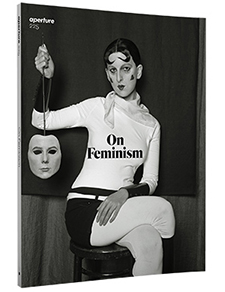
On Feminism
Aperture #225 (Winter 2016)
Aperture’s winter issue has focused “On Feminism.” In a moment that the very idea of gender is central to local and global conversations about equality, this approach arrives at a right moment to address the power and influence that women hold on the stage of the art world and beyond.
This issue focuses on intergenerational dialogues, debates, and strategies of feminism in photography, acknowledging the immense contributions by artists whose work articulates or interrogates representations of women in media and society. “On Feminism” features include a lively roundtable with curators from Paris and New York on modernist photographers between the wars, Nancy Princenthal on the feminist avant-garde of the 1970s, Eva Díaz on protest and visual politics, Laura Guy on lesbian erotica as critical rebellion, Eva Respini on abstraction, Julia Bryan-Wilson on visions of trans feminism, and a conversation with Renée Cox about black feminist icons, plus contributions from Martha Rosler and Maria Nicolacopoulou, among others, as well as portfolios by Farah Al Qasimi, Jennifer Blessing, Zackary Drucker, Catherine Morris, A. L. Steiner, Zanele Muholi, Yurie Nagashima, Elle Pérez, Laurie Simmons, Cosey Fanni Tutti, and Gillian Wearing.
The issue’s contents are organized in two main sections that underscores how photography has shaped feminism as much as how feminism has shaped photography. Use #OnFeminism to join the conversation on Twitter, Instagram, and Facebook.
Nairy Baghramian: Déformation Professionnelle
S.M.A.K.
Jan Hoetplein 1, 9000 Ghent, Belgium
November 26, 2016–February 19, 2017
S.M.A.K. presents Déformation Professionnelle, a solo exhibition by influential Iranian sculptor Nairy Baghramian. Born in 1971 in Isfahan, Iran, Baghramian is currently living and working in Berlin. She has become internationally known for her contextual approach to exhibition-making via sculpture and photography. Focusing in a site-responsive practice, her works explore the body and its supportive functions.
Déformation Professionnelle is a new production which builds on eighteen works in the artist’s oeuvre from 1999 to 2016. Baghramian alludes to existing work from discarded ideas to working material. In the artist’ words, she is “surveying the survey.” This body of work formulates fundamental questions about progress and economy, while interrogating what happens when something ceases to exist, and how something new comes into being.
The exhibition includes several large-scale works such as Class Reunion (2008), Retainer (2012), and French Curve (2014). Both inside and outside the museum,the display evidences the artist complex engagement with the transformation and consequent deformation of form, language, and meaning in its translation from one series into the other.
Nairy Baghramian | Déformation Professionnelle is organized by S.M.A.K. and the Walker Art Center in Minneapolis, where the exhibition will travel in October 2017.
The Artist as Entrepreneur
posted by CAA — Nov 14, 2016
 New York Foundation for the Arts, 20 Jay Street, Seventh Floor, Brooklyn, NY 11201
New York Foundation for the Arts, 20 Jay Street, Seventh Floor, Brooklyn, NY 11201
Participants: 60
Pricing: $50
Date: Tuesday, February 14, 2017
9:30 AM – 4:00 PM
This Valentine’s Day, the College Art Association (CAA) and the New York Foundation for the Arts (NYFA) are showing their love for artists by partnering to offer professional development programming, “The Artist as Entrepreneur,” the day before the CAA Annual Conference. This day-long event has been customized to fit the needs of CAA artist members but is open to all artists. It allows participants the opportunity to attend part of the CAA Annual Conference with a ticket to a session of their choice. Participants are also welcome to join numerous conference events that are open to the public.
NYFA’s “The Artist as Entrepreneur” is a course that teaches the fundamental principles of sustainability—and ultimately profitability—in the arts. This includes topics such as strategic planning, finance, and marketing. Additional material is drawn from NYFA’s popular textbook which accompanies this curriculum, The Profitable Artist (Allworth Press, 2011). The structure is a blend of formal lectures, breakout groups, and one-on-one meetings. Participants work through a flexible and dynamic “action plan,” which provides a blueprint for their practice or specific projects. Each receives specific feedback from experts in the field as well as their peers in the course.
Register for “The Artist as Entrepreneur.”
First come, first served.
To learn more about NYFA Learning, please see a list of programs on their website.
New and Forthcoming in CAA’s Journals
posted by CAA — Sep 12, 2016
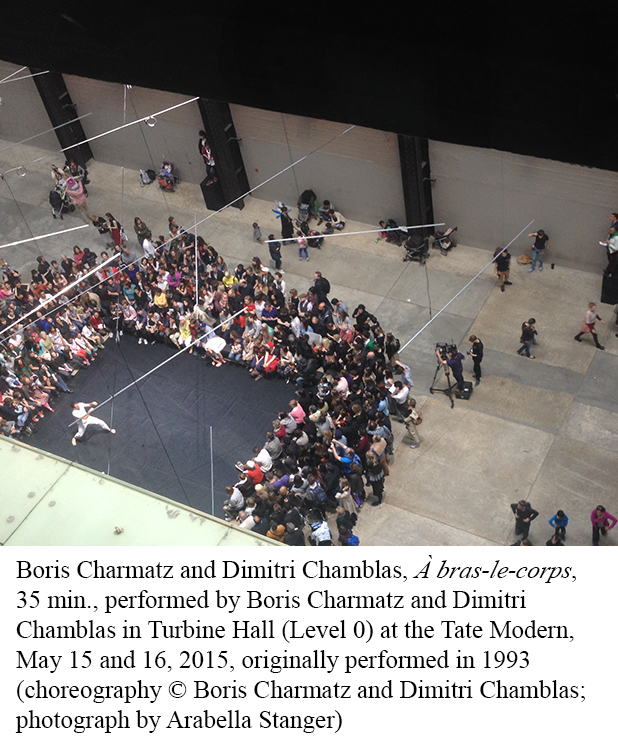 caa.reviews
caa.reviews
Boris Charmatz’s If Tate Modern Was Musée de la Danse? (May 15–16, 2015) is the focus of a new multimedia review on the Scalar platform, If caa.reviews were performance.reviews?. Organized by Juliet Bellow, the project includes an introduction by Bellow, and three reviews of the performances at the Tate Modern by Arabella Stanger, Nicole Zee, and Tamara Tomic-Vajagic. The review presents the complexities of Charmatz’s transformation of the Tate Modern into a museum of dance for two days and features an interactive map showing where the performances occurred in the Tate Modern, in addition to videos and still images. Charmatz’s project challenges conceptions of museums as institutional spaces and incorporates audience participation and “unauthorized” performances. This review is part of a new caa.reviews initiative to review time-based media works.
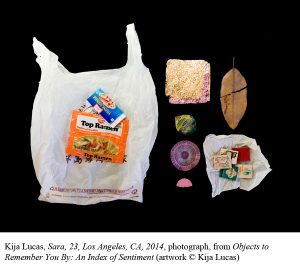 Art Journal Open
Art Journal Open
Art Journal Open this summer launched a new cluster of conversations featuring artist residencies, with artists who have participated in residencies interviewed by those who organize these programs. Through the conversations, Art Journal Open examines how residencies operate logistically and conceptually, and how they contribute to creative production. Conversations published in the series include Caitlin Masley-Chalet of Guttenberg Arts (Guttenberg, NJ) with artist Diana Shpungin, Vanessa Kauffman of Headlands Center for the Arts (Sausalito, CA) with artist Patricia Fernández Carcedo, and Amy Cancelmo of Root Division (San Francisco, CA) with artist Kija Lucas.
Earlier this summer, Art Journal Open published the third of a three-part series on appropriation as an artistic strategy: “Knight’s Heritage: Karl Haendel and the Legacy of Appropriation, Episode Three, 2013” by Natilee Harren, with a response by Nate Harrison. Recent features also include a review of Wetware: Art, Agency, Animation (Beall Center for Art + Technology, University of California, Irvine, February 6–May 7, 2016) by Charissa Terranova, and “Humans Have Been Human for So Long,” a dialogue between artist Shana Lutker and curator Mika Yoshitake on Lutker’s exhibition Shana Lutker: Le “NEW” Monocle, Chapters 1–3 at the Hirshhorn Museum and Sculpture Garden in Washington, DC (October 27, 2015–February 16, 2016).
Art Journal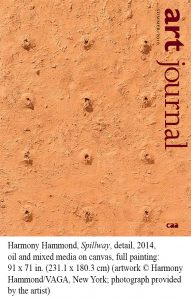
The forthcoming Fall 2016 Art Journal features a project by the artist Penelope Vlassopoulou, whose source material is the phrases and drawings carved in underground cells by detainees during the Nazi occupation of Greece. In other feature articles, Mario Merz’s fascination with the Fibonacci series is the cruz of Elizabeth Mangini’s examination of works created within the intellectual and political ferment of 1960s Italy, and Emily Hage rethinks Romare Bearden’s historical and political position in relation to the dense collages he made for the covers of Time and Fortune. The Reviews section includes Eve Meltzer’s account of the film Eva Hesse and reviews of books by Thomas Crow, Claire Robins, and Joan Kee. An annotated bibliography by Roger F. Malina, the astrophysicist who also serves as executive editor of Leonardo Publications/MIT Press, explores the highly productive intersections of art and science.
Recently published in the Summer 2016 Art Journal is a project by the renowned artist Harmony Hammond. The covers of the journal were given a waxy coating to convey the nature of her intensely tactile paintings and prints, featured in a twenty-page portfolio. In the features, Amanda Jane Graham takes a close look at the interweaving of domestic and performing spaces in Trisha Brown’s 1975 dance Locus; Mechtild Widrich investigates the effects on the urban fabric of the new/old National Gallery of Singapore, created from a colonial-era court building; and Dan Adler traces the idea of an all-pervasive Apparatus in 1980s and 1990s works by the German photographer Thomas Ruff. The Reviews section begins with Chris Taylor’s examination of the film Troublemakers: The Story of Land Art. Other reviews examine a new book by Chika Okeke-Agulu and the exhibition and catalogue Hippie Modernism. An annotated bibliography by Audra Wolowiec explores the poetics of sound and language.
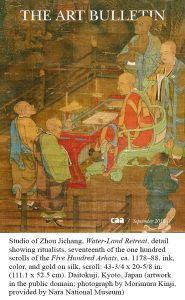 The Art Bulletin
The Art Bulletin
The cover of the September 2016 issue of The Art Bulletin depicts Buddhist monks evoking ghosts in a nocturnal ceremony; the large detail from a polychrome silk scroll accompanies Phillip E. Bloom’s essay on twelfth-century Chinese paintings of Buddhist rituals. In other essays featured in the September issue, Judy Sund reconsiders nineteenth-century perceptions of Watteau’s Pierrot character as forlorn, Christine I. Ho contextualizes a brush-and-ink painting created by a collective in the early People’s Republic of China, and James Nisbet surveys intersections of global politics and imaging in the site-specific art of Walter De Maria. In his “Whither Art History?” essay, Bárbaro Martínez-Ruiz explores Kongo visual and cultural practices in contemporary art.
The Reviews section, with a theme of “Urban Images, Memories, and Fragments,” includes four reviews of recent books on the cultures of fifth-century BCE Athens, seven Dutch cities from 1200 to 1700, early modern Rome, and Mexico City in light of Aztec civilization.
Taylor & Francis Online
In addition to their print subscription(s), CAA members receive online access to current and back issues of Art Journal and The Art Bulletin. Taylor & Francis, CAA’s publishing partner, also provides complimentary online access to Word and Image, Digital Creativity, and Public Art Dialogue for CAA members. To access these journals, please log into your account at collegeart.org and click the link to the CAA Online Publications Platform on Taylor & Francis Online.
Committee on Diversity Practices highlights for May/June 2015
posted by CAA — May 09, 2015
CDP Highlights
The CAA Committee on Diversity Practices highlights exhibitions, events, and activities that support the development of global perspectives on art and visual culture and deepen our appreciation of political and cultural heterogeneity as educational and professional values. Current highlights are listed below; browse past highlights through links at the bottom of this page.
May/June 2015
Kahlil Joseph: Double Conscience
Museum of Contemporary Art
Los Angeles, California
March 20, 2015–August 16, 2015
“Kahlil Joseph: Double Conscience is MOCA’s presentation of Kahlil Joseph’s m.A.A.d, a double screen projection that is a lush portrait of contemporary Los Angeles. The camera sinuously glides through predominantly African American neighborhoods, pausing to capture quotidian moments—driving in a car, a marching band, the barbershop—that are suffused with creativity, joy, and sadness. The split screen divides the viewer’s attention, and alludes to the history of auteur cinema—a form of filmmaking pioneered by French director Jean Luc Godard—which sacrificed linear narrative for experimentation with the formal and political possibilities of filmmaking. m.A.A.d extends this tradition of formal experimentation by crossing the wires of music videos, amateur film footage, and moments of magical realism. The two-part projection may also slyly evoke philosopher W.E.B. Dubois’s early twentieth century concept of “double consciousness,” a psychological description of Black life in America. The film’s verbally dense and thick booming soundtrack, provided by hip-hop artist Kendrick Lamar, adds yet another layer to this prismatic account of contemporary life in Los Angeles.” (http://www.moca.org/museum/exhibitiondetail.php?&id=503)
More information: http://www.moca.org
UNDER THE MEXICAN SKY: Gabriel Figueroa—Art and Film
Museo El Barrio
New York, New York
March 4, 2015–June 27, 2015
“From the early 1930s through the early 1980s, the Mexican cinematographer Gabriel Figueroa (1907–1997) helped forge an evocative and enduring image of Mexico. Among the most important cinematographers of the Golden Age of Mexican Cinema, Figueroa worked with leading directors from Mexico, the United States and Europe, traversing a wide range of genres while maintaining his distinctive and vivid visual style.
In the 1930s, Figueroa was part of a vibrant community of artists in many media, including Diego Rivera, Jose Clemente Orozco, Edward Weston and Manuel Alvarez Bravo, who sought to convey the country’s transformation following the trauma of the Mexican Revolution. Later, he adapted his approach to the very different sensibilities of directors Luis Buñuel and John Huston, among others. Figueroa spoke of creating una imágen mexicana, a Mexican image. His films are an essential part of the network of appropriations, exchanges and reinterpretations that formed Mexican visual identity and visual culture in the mid-twentieth century and beyond.
The exhibition features film clips, paintings by Diego Rivera, Jose Clemente Orozco, Manuel Rodriguez Lozano and José Chavez Morado, photographs, prints, posters and documents, many of which are drawn from Figueroa’s archive, the Televisa Foundation collection, the collections of the Museo de la Estampa and the Museo Nacional in Mexico. In addition, the exhibition includes work by other artists and filmmakers from the period such as Luis Buñuel, Sergei Eisenstein, Edward Weston, and Tina Modotti that draw from the vast inventory of distinctly Mexican imagery associated with Figueroa’s cinematography or were heavily influenced by his vision.” (http://www.elmuseo.org/under-the-mexican-sky/)
More information: http://www.elmuseo.org
Imagining New Worlds: Wilfredo Lam, Jose Parla, Fahamu Pecou
High Museum of Art
Atlanta, Georgia
February 14, 2015–May 24, 2015
“Imagining New Worlds traces the lengthy career of Wifredo Lam (1902-1982), perhaps best remembered as a member of the Surrealist group in the 1940s. Born in Cuba to a Chinese father and mother of African and Spanish descent, Lam gave expression to his multiracial and cultural ancestry through a signature hybrid style of painting that blended Surrealism, magical realism, modernism, and postmodernism. The exhibition begins with the academic work made while studying painting in Madrid, and includes the fantastical mid-century canvases that incorporate figures from the syncretic religion Santéria. His work is informed by a cross-cultural fusion of influences such as Afro-Cuban symbolism and Negritude, a movement that rejected the French colonial framing of African identity.” (http://www.high.org/Art/Exhibitions/Imagining-New-Worlds.aspx)
More information: http://www.high.org
Kehinde Wiley: A New Republic
Brooklyn Museum of Art
Brooklyn, New York
February 20, 2015–May 24, 2015
“The works presented in Kehinde Wiley: A New Republicraise questions about race, gender, and the politics of representation by portraying contemporary African American men and women using the conventions of traditional European portraiture. The exhibition includes an overview of the artist’s prolific fourteen-year career and features sixty paintings and sculptures.
Wiley’s signature portraits of everyday men and women riff on specific paintings by Old Masters, replacing the European aristocrats depicted in those paintings with contemporary black subjects, drawing attention to the absence of African Americans from historical and cultural narratives. The subjects in Wiley’s paintings often wear sneakers, hoodies, and baseball caps, gear associated with hip-hop culture, and are set against contrasting ornate decorative backgrounds that evoke earlier eras and a range of cultures. Through the process of “street casting,” Wiley invites individuals, often strangers he encounters on the street, to sit for portraits. In this collaborative process, the model chooses a reproduction of a painting from a book and reenacts the pose of the painting’s figure. By inviting the subjects to select a work of art, Wiley gives them a measure of control over the way they’re portrayed. The exhibition includes a selection of Wiley’s World Stagepaintings, begun in 2006, in which he takes his street casting process to other countries, widening the scope of his collaboration. Kehinde Wiley: A New Republic is organized by Eugenie Tsai, John and Barbara Vogelstein Curator of Contemporary Art, Brooklyn Museum. A fully illustrated catalogue published by the Brooklyn Museum and DelMonico Books • Prestel accompanies the exhibition.” (http://www.brooklynmuseum.org/exhibitions/kehinde_wiley_new_republic/)
More information: http://www.brooklynmuseum.org/home.php
Diego Rivera and Frida Kahlo in Detroit
Detroit Institute of Arts
Detroit, Michigan
March 15, 2015–July 12, 2015
“Diego Rivera and Frida Kahlo were an explosive couple. He carried a pistol. She carried a flask. He romanticized Detroit. She rejected it. But what they shared was a belief in communism, a thirst for tequila and a passion for each other. Discover how they left their mark on Detroit. And how Detroit left its mark on their art. Exclusively on view at the Detroit Institute of Arts, Diego Rivera and Frida Kahlo in Detroit brings together nearly 70 works of art that depict the evolution of these two extraordinary artists’ careers, including eight of Rivera’s epic preparatory drawings for the Detroit Industry murals and 23 pieces by Kahlo, whose work has never before been shown at the DIA.” (http://www.dia.org/calendar/event.aspx?id=4608&iid=)
More information: http://www.dia.org
Committee on Women in the Arts Picks for February 2015
posted by CAA — Feb 10, 2015
Each month, CAA’s Committee on Women in the Arts selects the best in feminist art and scholarship. The following exhibitions and events should not be missed. Check the archive of CWA Picks at the bottom of the page, as several museum and gallery shows listed in previous months may still be on view or touring.
February 2015
The February CWA Picks are dedicated to Kalliopi Minioudaki for her tremendous efforts in working on the Picks during her tenure on the CWA (2012–15). You will be missed!
Poetry and Exile
British Museum
Gallery 34, Great Russell Street, London
WC1B 3DG United Kingdom
October 1, 2014–March 1, 2015
Housed within the Islamic World Galleries, Poetry and Exile displays a series of works by artists of the Middle East and North Africa recently acquired by the British Museum. This small but powerful exhibition explores the effects of exile through the eyes of four women artists:Ipek Duben, Mireille Kassar, Mona Saudi, and Canan Tolon.
Tolon’s series ofink and graphite drawings, titled Futur Imparfait, is a memoir fromher exile from Istanbul to France, where she spent a decade in hospital as a result of contracting polio as a child. In the series Tolon portrays an exile not only from home, but also from her own body. Duben’s book Refugee belies the helplessness and terror suffered by people forced to flee their homeland with images on delicate gauze pages and using childlike embroidery that depicts the crossing of borders. The Istanbul-born Duben has been making books and installations that focus on identity, domestic violence, and the worldwide forced migration of the twentieth century.
The Jordanian artist Saudi combines the evocative verses of the Palestinian poet Mahmoud Darwish with drawings, while the Lebanese-born Kassar developed a series of drawings inspired by the Persian poem The Conference of the Birds. Here, Kassar conjures a story of exile from her own family history. Originally from Mosul and Mardin—present day Iraq and Turkey—her ancestors fled the Ottoman massacres of minorities during the late-nineteenth and early twentieth century.
Zoe Strauss: Sea Change
Cantor Fitzgerald Gallery
Haverford College, Whitehead Campus Center, 370 Lancaster Avenue, Haverford, PA 19041
January 23–March 6, 2015
Cantor Fitzgerald Gallery presents Sea Change, an exhibition of photographs, vinyl prints, and projected images by Zoe Strauss. Throughout this project, the celebrated Philadelphia photographer traces the aftermath of Hurricane Katrina in 2005, the BP Deepwater Horizon oil spill in southern Louisiana in 2010, and Hurricane Sandy in 2012: three ecological disasters that have changed America’s landscape.
With little formal training as a photographer or artist, Strauss (b. Philadelphia, 1970) uses photography as the most direct means of representing her chosen subjects. Her images, often both disturbing and touching, are focused mainly on American working-class experience. She founded the Philadelphia Public Art Project in 1995 with the aim of exhibiting art in nontraditional venues in order to give the citizens of Philadelphia access to art in their everyday lives. She now refers to this initiative as an “epic narrative” of her own neighborhood that reflects the beauty and struggle of everyday life.
True to her creative statement, Strauss captures the fast and slow tragedies of global warming through the portrayal of an irreparable damage and the hope of mending. Flattened sceneries and architectural remains stand alongside graffiti and signs including encouraging pleas, words that express the despair of a sudden displacement as much as the hope to return and belong, again. Sea Change is accompanied by a publication designed by Random Embassy.
Otobong Nkanga: Tracing Confessions
Museum Folkwang
Museumsplatz 1, 45128 Essen, Germany
January 23–May 18, 2015
Museum Folkwang presents Tracing Confessions, a two-part project created by Otobong Nkanga (born Nigeria, 1974). Based in the museum collection, Nkanga explores issues of identity and relationships between objects and people. As part of the Kunststiftung NRW’s project 25/25/25, Nkanga invited members of the museum’s staff to be photographed with selected pieces from this collection. During the month of January, the resulting photographs will be distributed as billboards throughout the city. Bringing the museum to the public space, the piece aims to connect with Essen residents in their everyday lives. This public intervention is presented along an installation designed specifically for the museum. Unveiling shared stories between objects and people, Tracing Confessions interrogates the origin of the museum artifacts, and in that their potential of shaping identities.
Trained in the converging traditions of performance and live arts, Nkanga leads an intensive research-based artistic practice. Her heterogeneous and multidisciplinary practice includes drawing, photography, installation, and performance art. Her sensitive observation on social and topographical changes in the environment, and on the concept of diaspora, examines the regional and cultural complexities that are embedded in these experiences. Using her own and others’ body and voice, Nkanga proves that the subjects of her projects are to be a lived and truly embodied experience. Through language and visual and physical narratives, her work invites viewers to engage in a dialogue that reflects on identity, memory, and perception.
Carolee Schneemann: Infinity Kisses
Merchant House
Herengracht 254, 1016BV, Amsterdam, the Netherlands
January 22–April 12 2015
The Merchant House in Amsterdam presents Carolee Schneemann: Infinity Kisses, an exhibition of works on paper, photographs, and a video by the renowned American multimedia artist. The exhibition pivots on a site-specific installation of the video Infinity Kisses-The Movie (2008), first shown in Amsterdam. The show is also accompanied with a fully illustrated catalogue with an essay by Kalliopi Minioudaki.
The experiential body—yet not only her own naked one, as this exhibition argues—has been paramount in Carolee Schneemann’s multifariously radical politics and idiosyncratic poetics. Focusing on the photographic series (2004) and video (2008) that sensually portray the morning kisses given to Schneemann by her cats, Cluny and Vesper, this exhibition foregrounds the radical centrality of the cat in her work—as lifelong companion and a symbol of what patriarchal culture represses and dismisses, namely female sexuality. Returning Schneemann’s legendary yet controversial interspecies “kisses” to a house that variously evokes her own—due to the fact that the Merchant House is located in a historic canal house that reminds the artist of her home in Springtown, New York, itself central in her production—this exhibition highlights the domesticity that characterizes the poetics of intimacy inherent in a great part of her work.
In contrast to the ecstatic bodies of Infinity Kisses, the accompanying works in the exhibition juxtapose gruesomely violated or caged feline bodies with news images of global atrocities. Sampling the gestural painterliness and collage aesthetics that underpin much of her work, these prints hint at the darker role the body plays in Schneemann’s sorrowful diagnosis of the malaises of modernity and patriarchy, of Western civilization, and of the current stage of the society of spectacle. An extraordinary example of her conceptual feminist poetics, Unexpectedly Research (1992) illuminates the research and “double knowledge” that underpin not only Schneemann’s feminist critique of the suppression of the sacred feminine, but also its radical bodily retrieval by the artist.

Janet Biggs, production still from Can’t Find My Way Home, 2015, four-channel video, high-definition video installation with sound, 8:35 min. (artwork © Janet Biggs)
Janet Biggs: Echo of the Unknown
Blaffer Art Museum
University of Houston,
120 Fine Arts Building, Houston, TX 77204-4018
January 17–March 21, 2015
Janet Biggs: Echo of the Unknown is part of the Science Spring at the Blaffer Art Museum. Organized by the independent curator Janet Phelps, this multidisciplinary exhibition combines video, sound, and objects to explore the role of memory in the construction of identity. Drawing from the artist’s personal memories of the effects of Alzheimer’s on various family members, stories of public figures coping with the disease, and research conducted with neurologists and geoscientists, Echo of the Unknown raises fundamental questions about how we become—and how we lose our sense of—who we are.
Works in the exhibition include Can’t Find My Way Home, a four-channel video installation inspired by memories of the artist’s grandfather, an avid mineral collector who could recall the most difficult names of mineral species yet not his own as he succumbed to the disease. This piece juxtaposes documentation of neurological research conducted in New York and Houston laboratories with footage shot in the crystal cavern below the Merkers salt mine in Germany, itself a potent metaphor for the brain and its sites of memory.
The video installation The Persistence of Hope focuses on the solace Biggs’s uncle found in his residual memory of birds. Only after his death Biggs discovered her uncle’s peculiar ritualized attempt to sustain beauty and hold onto life as he felt it fade away by gathering hummingbirds and placing them in his freezer. Alternating imagery of gravity-defying hummingbirds with footage shot in the Arctic and in laboratories where human brain cells are preserved in freezers for neurological research, The Persistence of Hope paints a tender picture of life caught between hope and futility.
Breathing without Air follows an aging mineral collector as he searches for the perfect specimen at a trade show, where he eventually loses his way among the many aisles of vendors and displays. All three pieces share a soundscape based on Glen Campbell’s 1968 song “Wichita Lineman.” Comprising scores based loosely on Campbell’s tune by various composers, Biggs’s Wichita Lineman is a haunting sonic homage to the tenacity of Campbell who, upon his diagnosis with Alzheimer’s, decided to continue to tour for as long as he could.
An ambitious series of lectures, gallery talks and panel discussions accompanies the exhibition throughout its duration, enhancing the exhibition’s role as a catalyst for cross-disciplinary learning.
Lynn Hershman Leeson: Civic Radar
ZKM | Karlsruhe
Lorenzstraße 19, 76135 Karlsruhe, Germany
December 13, 2014–April 6, 2015
Lynn Hershman Leeson has been mining body art and new media for more than forty years. Her cutting-edge work has run a broad gamut that ranges from the feminist performance Roberta Breitmore, for which she lived a double life as herself and an alter ego for most of the 1970s, to a series of science-fiction films starring Tilda Swinton. Acknowledged for her feminist politics, Hershman Leeson chronicled the feminist movement in the 2011 documentary Women Art Revolution. Yet her contributions to technologically sophisticated art have been widely understudied. Conversely, Lynn Hershman Leeson: Civic Radar, the first comprehensive retrospective of her work in a museum and especially in Germany, not only overviews all the creative phases of her work, bringing together rarely shown early works like her 1960s wax and burned sculptures along with masterful highlights, but it also strives to acknowledge her pioneering role as an innovative and influential new-media artist.
As such Civic Radar brings together works that exemplify Hershman Leeson’s multimedia investigation of identity and various modes of surveillance, such as Lorna (1983/84), one of the first interactive projects on videodisc, and Teknolust (2002), which addresses cyberidentity, artificial intelligence, cloning, and the decoupling of sexuality and human reproduction. The exhibition also include recent works that use robots, mass-communication media such as smart-phones, and the latest scientific developments in the field of genetics and regenerative medicine, including three-dimensional bioprinters that create human body parts.
Hershman Leeson received a bachelor of science in museum administration and art at Case Western Reserve University in Cleveland and a master of arts in art criticism at San Francisco State University. From 1993 through 2004 she was professor of electronic arts at the University of California, Davis. From 2004 through 2010 Hershman Leeson held the Andrew D. White Chair at Cornell University in Ithaca. In 2007 the artist assumed charge of the San Francisco Art Institute’s Film Department. Over the years, she has received numerous awards, including the Siemens Medienkunst Preis in 1995 and the Prix Ars Electronica (Golden Nica) in 1995.



